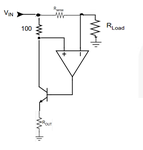anve
Newbie level 4

Hi everyone,
I am new to this forum and its my first post.This site has provided me a better way of understanding electronics.Thanks for that.
The circuit I have designed is for tripping off the power to motor when excess current flows through it at the time of stalling.(see the attached schematic).
[*]The current flowing through the motor is monitored across a current sense resistor (shunt resistor 0.5 ohm)which is connected to the positive terminal of the op amp lm324.
[*]The voltage drop across the shunt resistor is of the order of millivolts which is amplified by the first stage op-amp and given to positive terminal of the second stage lm324 op-amp which is configured as a comparator.
[*]The comparator output is fed to the gate of the SCR 2N5063 which operates the relay.(Earlier I used BC547 instead of SCR for turning on the relay.The result was annoying relay chattering.So I switched to SCR)
[*]When the relay is operated the motor stops and the led glows.
[*]The relay remains ON until the power is reset.
The problem is
The SCR is turning at unwanted times like :
>Switching on the power supply.
>Changing direction of the motor.
>Sometimes it turns on before the stalling current is reached.
Addition of a capacitor as a negative feedback(shown in fig.) from output terminal to negative terminal solved the issue to some extend(i.e. sometimes it works properly).But still it doesn't give consistent results.
This is a simple design problem.Either I am doing something realy stupid or I am not doing something really smart.Either case I need your help on the following:
1)Identify the fault if any in the design and suggest a practical solution.
2)let me know if there is any standard design for current sense-&-turn-of-motor-on-stalling-using-relay circuit.
P.S.there are lot of micro controller based solutions for the problem.But for this particular project the circuit should be purely analogue(w/o uC).
Eagerly waiting for your valuable comments
Thanks in advance
Anve
- - - Updated - - -
hello again,
The circuit I uploaded had a small mistake. I'm attaching it again after the correction.
Thanks
Anve
I am new to this forum and its my first post.This site has provided me a better way of understanding electronics.Thanks for that.
The circuit I have designed is for tripping off the power to motor when excess current flows through it at the time of stalling.(see the attached schematic).
[*]The current flowing through the motor is monitored across a current sense resistor (shunt resistor 0.5 ohm)which is connected to the positive terminal of the op amp lm324.
[*]The voltage drop across the shunt resistor is of the order of millivolts which is amplified by the first stage op-amp and given to positive terminal of the second stage lm324 op-amp which is configured as a comparator.
[*]The comparator output is fed to the gate of the SCR 2N5063 which operates the relay.(Earlier I used BC547 instead of SCR for turning on the relay.The result was annoying relay chattering.So I switched to SCR)
[*]When the relay is operated the motor stops and the led glows.
[*]The relay remains ON until the power is reset.
The problem is
The SCR is turning at unwanted times like :
>Switching on the power supply.
>Changing direction of the motor.
>Sometimes it turns on before the stalling current is reached.
Addition of a capacitor as a negative feedback(shown in fig.) from output terminal to negative terminal solved the issue to some extend(i.e. sometimes it works properly).But still it doesn't give consistent results.
This is a simple design problem.Either I am doing something realy stupid or I am not doing something really smart.Either case I need your help on the following:
1)Identify the fault if any in the design and suggest a practical solution.
2)let me know if there is any standard design for current sense-&-turn-of-motor-on-stalling-using-relay circuit.
P.S.there are lot of micro controller based solutions for the problem.But for this particular project the circuit should be purely analogue(w/o uC).
Eagerly waiting for your valuable comments
Thanks in advance
Anve
- - - Updated - - -
hello again,
The circuit I uploaded had a small mistake. I'm attaching it again after the correction.
Thanks
Anve



